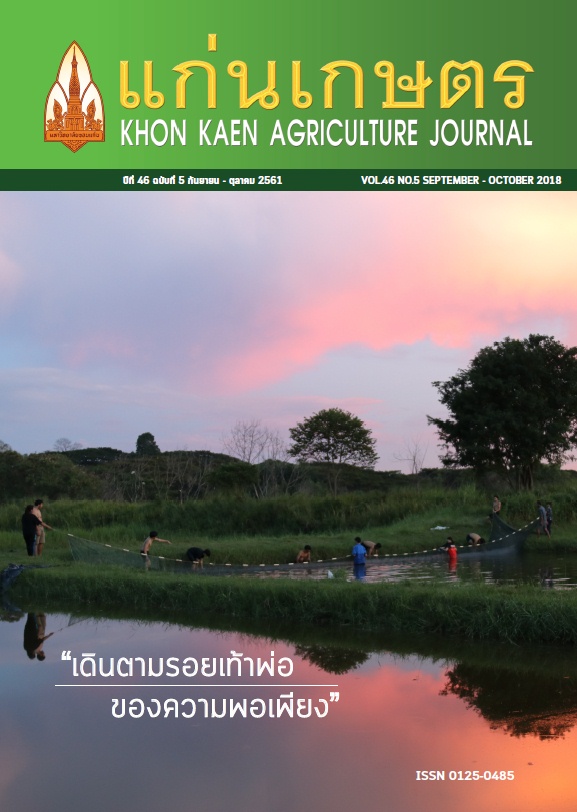ผลของยีสต์ Saccharomyces cerevisae ต่อคุณค่าทางโภชนะ และคุณภาพของฟางข้าวหมัก
Main Article Content
บทคัดย่อ
การเพิ่มคุณค่าทางอาหารของแหล่งวัตถุดิบอาหารหยาบมีความสำคัญมากต่อการเพิ่มประสิทธิภาพการผลิตสัตว์เคี้ยวเอื้อง วัตถุประสงค์การวิจัยครั้งนี้เป็นการใช้ยีสต์ Saccharomyces cerevisae หมักฟางข้าว เพื่อเพิ่มคุณค่าทางโภชนะของฟางข้าวหมักยีสต์ และศึกษากระบวนการหมักฟางข้าวหมักยีสต์ การทดลองใช้ฟางข้าวสับให้มีขนาด 5-10 เซนติเมตร วางแผนการทดลองแบบสุ่มสมบูรณ์ (CRD) แบ่งการทดลองออกเป็น 4 กลุ่ม ๆ ละ 3 ซ้ำ กลุ่มที่ 1 กลุ่มควบคุม กลุ่มที่ 2 ฟางข้าวหมักยีสต์ S. cerevisae ในสัดส่วน 500 กรัม: 500 มิลลิลิตร กลุ่มที่ 3 ฟางข้าวหมักยีสต์ S. cerevisae ในสัดส่วน 1,000 กรัม: 500 มิลลิลิตร และกลุ่มที่ 4 ฟางข้าวหมักยีสต์ S. cerevisaeในสัดส่วน 1,500 กรัม: 500 มิลลิลิตร คลุกเคล้าให้เข้ากัน และบรรจุใส่ถุงหมักไล่อากาศออกให้มากที่สุด ปิดปากถุงหมักให้แน่น ทำการหมักฟางข้าวทุกกลุ่มทดลองเป็นระยะเวลา 30 วัน เมื่อสิ้นสุดการหมัก สุ่มฟางข้าวหมักทุกกลุ่มทดลองวิเคราะห์องค์ประกอบทางเคมีของฟางข้าวหมักและปริมาณยีสต์ พบว่าปริมาณโปรตีนหยาบของฟางข้าวในกลุ่มที่ 1, 2, 3 และ 4 เท่ากับ 1.38, 4.65, 3.92 และ 3.80 เปอร์เซ็นต์บนฐานวัตถุแห้ง มีความแตกต่างกัน อย่างมีนัยสำคัญทางสถิติ (P < 0.01) ตามลำดับ และค่าคาร์โบไฮเดรตที่ย่อยง่าย กลุ่มที่ 1, 2, 3 และ 4 เท่ากับ 0.14, 3.73, 2.88 และ 2.81 เปอร์เซ็นต์บนฐานวัตถุแห้ง (P < 0.01) ตามลำดับ นอกจากนี้ยังพบว่ากรดแลคติกในฟางข้าวที่หมักร่วมกับยีสต์ในกลุ่มที่ 2 มีค่ากรดแลคติกสูงที่สุด คือ 2.85 เปอร์เซ็นต์ของวัตถุแห้ง และพบว่ากลุ่มทดลองที่ 2 ให้ปริมาณเชื้อยีสต์มีค่าสูงที่สุดเท่ากับ 0.9 x107 เซลล์/มิลลิลิตร นอกจากนี้ ผลการทดลองนี้แสดงให้เห็นว่าสัดส่วนการหมักฟางข้าวร่วมกับยีสต์ในกลุ่มทดลองที่ 2 (500: 500) มีความเหมาะสมต่อการปรับปรุงคุณภาพฟางข้าวหมัก โดยเฉพาะการเพิ่มสัดส่วนโปรตีนหยาบ คาร์โบไฮเดรตที่ย่อยง่าย และกรดแลคติก
Article Details
เอกสารอ้างอิง
เมธา วรรณพัฒน์. 2533. โภชนศาสตร์สัตว์เคี้ยวเอื้อง. ภาควิชาสัตวศาสตร์ คณะเกษตรศาสตร์ มหาวิทยาลัยขอนแก่น.
วิโรจน์ ภัทรจินดา. 2546. Dairy Cattle. ภาควิชาสัตวศาสตร์ คณะเกษตรศาสตร์ มหาวิทยาลัยขอนแก่น.
เสมอใจ บุรีนอก, เฉลิมพล เยื้องกลาง, ไกรสิทธิ วสุเพ็ญ, ศศิพันธ์ วงศ์สุทธาวาส, คำสอน สีสะอาด และ Yasuhiro Kawamoto. 2552. การใช้แบคทีเรียกรดแลคติกในน้ำหญ้าหมักเป็นเชื้อตั้งต้น ในอาหารผสมครบส่วนหมัก.แก่นเกษตร. 37: 245-254.
สายัณห์ ทัดศรี. 2540. พืชอาหารสัตว์เขตร้อนการผลิตและการจัดการ. ภาควิชาพืชไร่นา คณะเกษตรมหาวิทยาลัยเกษตรศาสตร์.
AOAC. 1990. Official Methods of Analysis of the Association of Official Analysis Chemists. 15thEdition. As sociation of Official Analytical Chemists. Arlington, AV, USA.
Axelsson, L.T. 1993. Lactic Acid Bacteria : Classification and physiology. In Salminen, S., Ed. Von Wright, A. Lactic Acid Bacteria. Marcel Dekker, New York.
Bromner, J.M., and D.R. Keeney. 1965. Steam distillation methods of determination of ammonium nitrate and nitrite. Anal. Chem. Acta. 32: 485-495.
Brown, S.W., S.G. Oliver, D.E.F. Harrison, and R.C. Righelato. 1981. Ethanol inhibition of yeast growth and fermentation: Differences in the magnitude and complexity of the effect. Applied Microbiology and Biotechnology. 11: 151-155.
Driehuis, F., S. J. W. H. Oude Elferink, and P. G. Van Wikselaar. 2001. Fermentation characteristics and aerobic stability of grass silage inoculated with Lactobacillus buchneri, with or without homofermentative lactic acid bacteria. Grass Forage Sci. 56: 330-343.
Dubois, M., K. A. Gilles, J. K. Hamilton, P. A. Rebers, and F. Smith. 1956. Colorimetric Method for Determination of Sugars and Related Substances. Anal. Chem. 28: 350-356.
Fenner, H., and J. M. Elliot. 1963. Quantitative method for determining the steam volatile fatty acids in rumen fluid by gas chromatography. J. Anim. Sci: 22: 624-627.
Filya, I. 2003. The effect of Lactobacillus buchneri and Lactobacillus plantarumon the fermentation, aerobic stability and ruminal degradability of low dry matter corn and sorghum silages. J. Dairy Sci. 86: 3575–3581.
Griffin, D.H. 1994. Fungal Physiology 2 nded. John Wiley and Sons Publication. U.S.A.Humpreys, L.R. 1991. Tropical Pasture Utilisation. Cambridge University Press, Cambridge.
Longland, A.C., C. Barfoot, and P.A.Harris. 2009. The loss of water soluble carbohydrates and soluble protein from nine different hays soaked in water for up to 16 h๐. J. Equine Vet. Sci. 29: 383-384.
McDonald, P., R. A. Edwards, and J. F. D. Greenhalgh. 1988. Animal Nutrition. 4th ed. JohnWiley& Sons, Inc., New York. USA.
Nagodawithana, W. Tilak. Castellano Carmine, and H. Keith. Steinkraus. 1974. Effect of Dissolved Oxygen, Temperature, Initial Cell Count , and Sugar Concentration on the Viability of Saccharomyces cerevisae in Rapid Fermentation. Applied Microbiology. 28: 383-391.
Oude-Elferink, S. J., J. Krooneman, J. C. Gottschal, S. F. Spoelstra, F. Faber, and F. Driehuis. 2001. Anaerobic conversion of lactic acid to acetic acid and 1, 2-propanediol by Lactobacillus buchneri. Appl. Environ. Microbiol. 67:125–132.
Perdok, H. B., and R. A. Leng. 1990. Effect of supplementation with protein meal on the growth of cattle given abasal diet of untreated or ammoniated rice straw. Asian-Aust. J. Anim. Sci. 3: 269-279.
SAS. 2006. STAT User’s Guide Release 9.1.3. NC: SAS Inst.
Skerman, P.J., and F. Riverson. 1990. Tropical Grasses. Food and Agricultural Organization of the United Nations. Rome.
Van Soest, P. J. 1994. Nutrition Ecology of the Ruminant. 2nd Edition. Cornell University. Press, USA.
Weinberg, Z.G., and R.E. Muck. 1996. New trends and opportunities in the development and use of inoculants for silage. FEMS Microbiological Reviews 19: 53–68.
Woolford, M.K. 1984. The Silage Fermentation. [Microbiological Series, No.14] New York, NY, USA.


